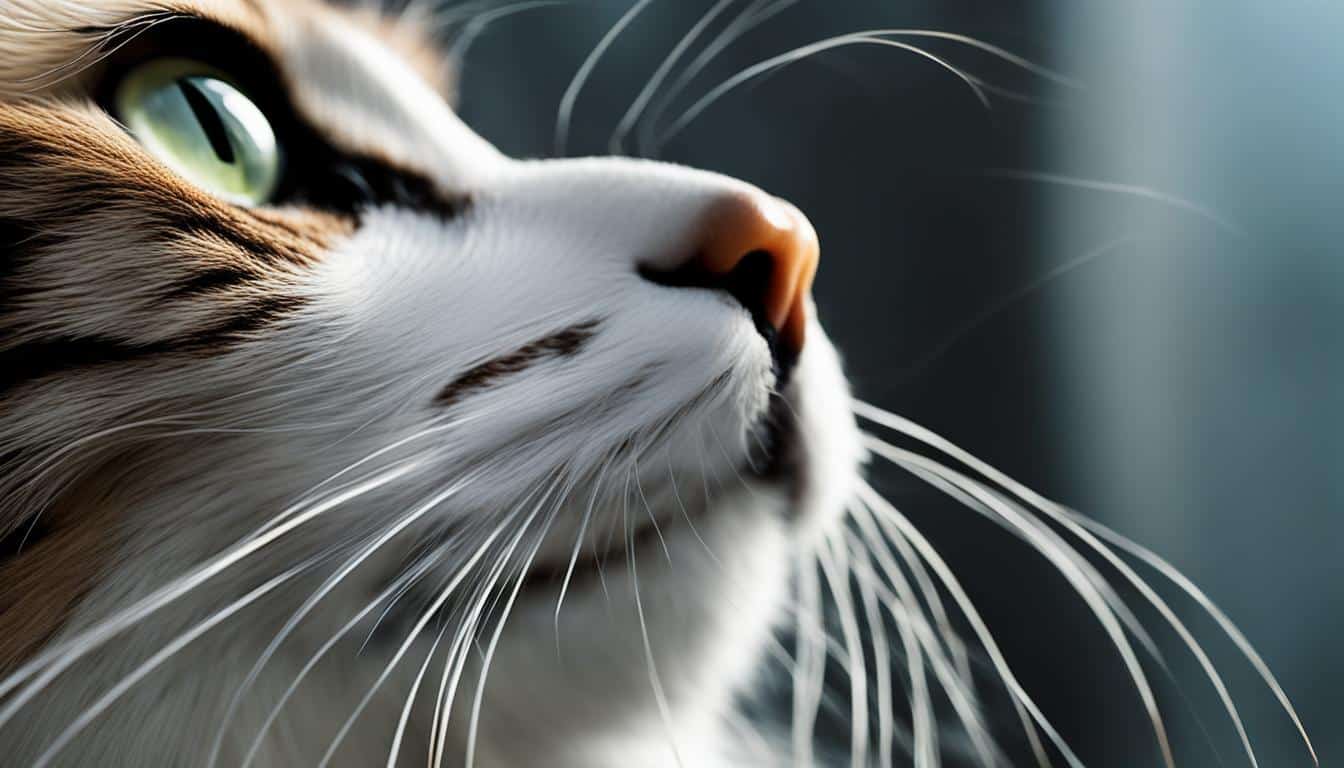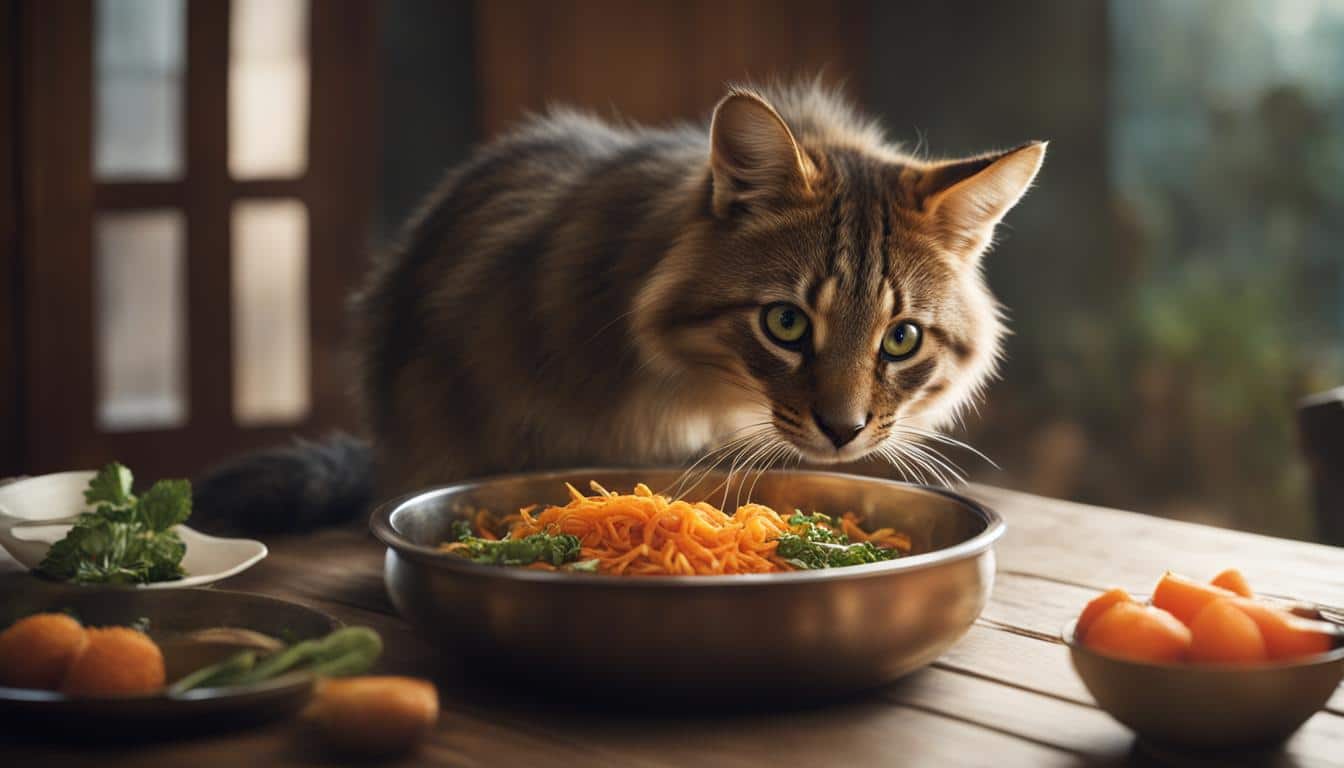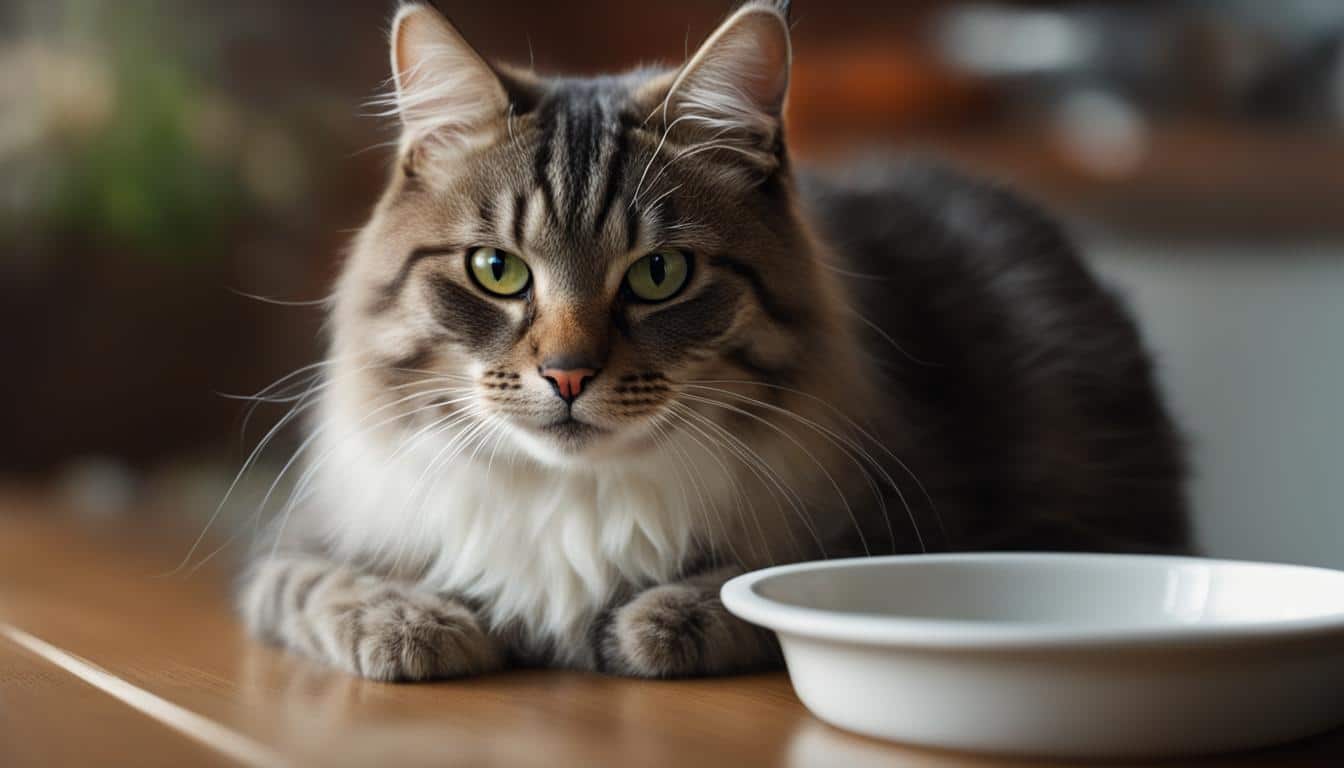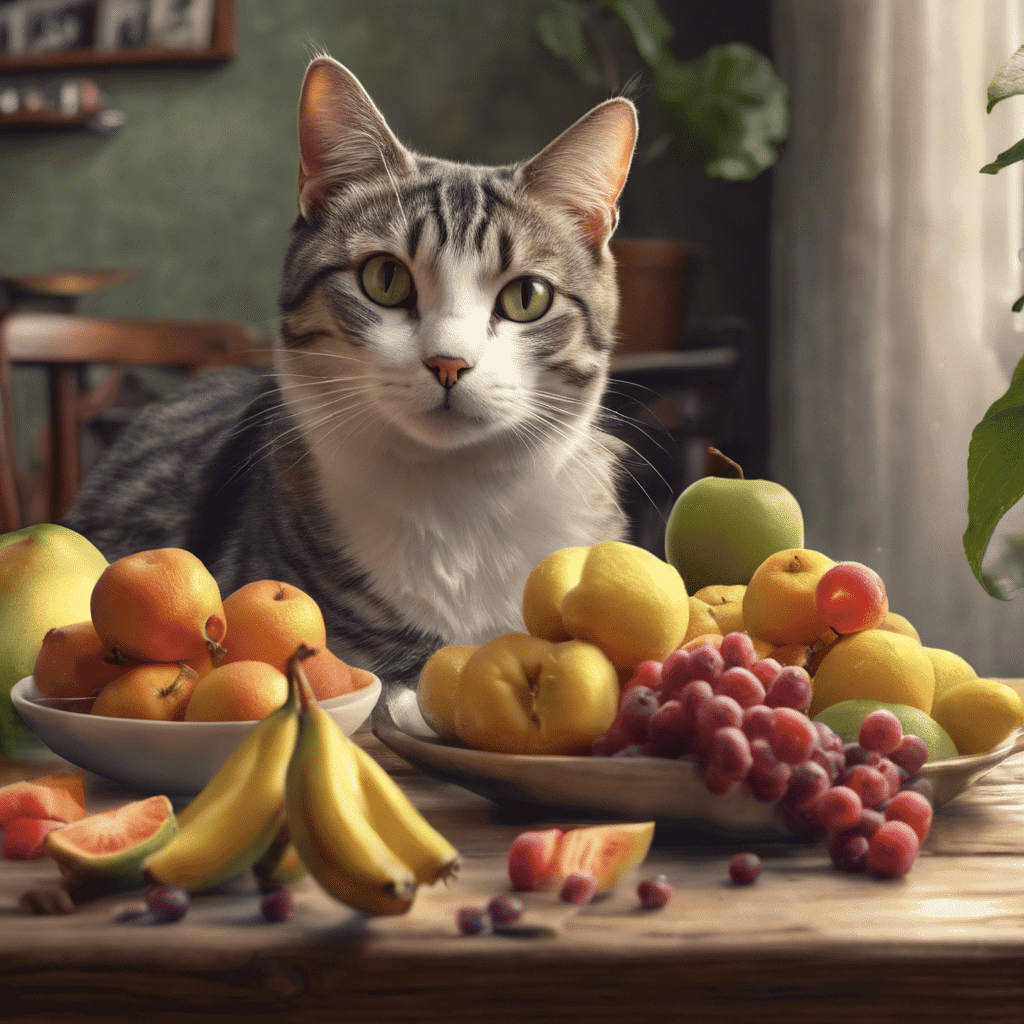Whisker fatigue is a condition that can affect your cat’s overall well-being. Understanding the signs of whisker fatigue is crucial for identifying and addressing this issue. By recognizing these symptoms, you can take steps to alleviate your cat’s discomfort and ensure a more pleasant mealtime experience.
In this section, we will explore the signs of whisker fatigue, allowing you to better understand your furry friend’s needs.

Key Takeaways |
|---|
| Whisker fatigue can cause discomfort and stress for your cat during mealtime. |
| Signs of whisker fatigue include not settling in front of their food or water bowl, trying to eat but not eating, tipping the bowl over to eat off the floor, and new food aggression behavior. |
| Recognizing these signs is important for addressing whisker fatigue and providing a more comfortable feeding experience for your cat. |
| Using wide, flat bowls or plates can help alleviate whisker stress. |
| If switching bowls or plates doesn’t solve the problem, consult with your veterinarian for further guidance. |
What is Whisker Fatigue?
Whisker fatigue is a condition that occurs when a cat’s whiskers are overstimulated, leading to discomfort and stress. Whiskers, also known as vibrissae, are not just decorative features on a cat’s face; they serve an important sensory function.
The nerve endings at the base of the whiskers help cats navigate their surroundings, determine if they can fit into tight spaces, and even sense changes in air currents. However, when these whiskers are constantly stimulated, it can overwhelm a cat’s sensory system and result in whisker fatigue.
Whisker fatigue is more of an overstimulation issue rather than actual fatigue. It can be caused by various factors, such as eating and drinking from narrow or deep bowls that constantly brush against the cat’s whiskers.
However, any form of stimulation that repeatedly activates the whiskers can contribute to whisker fatigue. This includes brushing against objects, rubbing against surfaces, or even interactions with other animals.
When the whiskers are overstimulated, it can cause stress and discomfort for the cat, leading to behavioral changes and a decrease in overall well-being.
To understand how whisker fatigue can affect cats, it is important to recognize the significance of their whiskers as sensory organs.
The table below highlights some key points about feline whiskers and their role in a cat’s sensory perception:
Whisker Function |
Significance |
|---|---|
| Orienting | Whiskers help cats navigate in low-light conditions and gauge their surroundings. |
| Size Detection | Whiskers can determine if a cat can fit through narrow spaces without getting stuck. |
| Object Detection | Whiskers can detect changes in air currents, helping cats sense approaching objects or animals. |
Understanding the role of whiskers and the impact of whisker fatigue can help cat owners take steps to alleviate this condition. By providing wide, flat bowls or plates for food and water, you can minimize whisker stimulation during mealtime. This allows for easier access to food and reduces the chances of whisker stress.
Additionally, being mindful of your cat’s interactions with other animals or objects can help prevent overstimulation of the whiskers in their daily activities.

Whisker fatigue is a real issue that can impact a cat’s well-being.
By understanding the causes and symptoms of whisker fatigue and taking proactive measures to prevent it, you can ensure that your furry friend has a comfortable and stress-free experience.
Consider implementing the suggestions mentioned above and consult with your veterinarian for further guidance on managing whisker fatigue.
Whisker Fatigue Symptoms
If you suspect that your cat may be experiencing whisker fatigue, it’s important to look out for certain signs that indicate this condition. Paying attention to your cat’s behavior during mealtime can give you valuable insights into their comfort levels. Here are some common signs of whisker fatigue to watch out for:
- Not settling in front of their food or water bowl: If your cat avoids staying near their bowl or seems reluctant to approach it, it could be a sign of discomfort caused by whisker fatigue.
- Trying to eat but not eating: If your cat appears hungry but takes a few bites or nibbles before stepping away from their food, it may be due to the overstimulation of their whiskers.
- Tipping the bowl over to eat off the floor: Some cats with whisker fatigue may resort to tipping their food bowl over and eating directly from the floor. This behavior helps them avoid the discomfort of their whiskers touching the sides of the bowl.
- New food aggression behavior: Whisker fatigue can also manifest as an increase in food aggression or a change in your cat’s eating habits. They may become more protective of their food or exhibit behavior such as growling or hissing.
These behaviors should not be ignored, as they can indicate that your cat is experiencing stress and discomfort during mealtime. By recognizing these signs, you can take steps to alleviate whisker fatigue and create a more pleasant dining experience for your feline friend.
How to Relieve Whisker Fatigue
If your cat is showing signs of whisker fatigue, there are several steps you can take to provide relief and create a more comfortable feeding experience. One option is to switch to a wide, flat bowl that allows your cat’s whiskers to clear the sides. This will prevent overstimulation of the whiskers and reduce the discomfort your cat may be experiencing.
Another alternative is to try using a plate instead of a traditional bowl. A plate provides more surface area for your cat to eat from, minimizing the chances of whisker stress. This can help your cat feel more at ease during mealtime.
Additionally, you can consider feeding your cat smaller, more frequent meals to avoid overwhelming their sensitive whiskers. By spacing out their meals, your cat will have time to recover from any overstimulation and reduce the likelihood of whisker fatigue.
Methods to Relieve Whisker Fatigue |
Description |
|---|---|
| Switch to a wide, flat bowl | This allows your cat’s whiskers to have space to move freely without being stimulated and prevents discomfort during feeding. |
| Try using a plate | A plate provides more surface area for your cat to eat from, reducing whisker stress and promoting a more comfortable mealtime experience. |
| Feed smaller, more frequent meals | By spacing out their meals, your cat’s whiskers will have time to recover, reducing the likelihood of overstimulation and whisker fatigue. |
It’s important to observe your cat’s behavior and monitor their response to these changes. Each cat is unique, so you may need to experiment with different feeding options to find what works best for your furry friend. If the symptoms of whisker fatigue persist or worsen, it is recommended to consult with your veterinarian for further guidance and support.
Before You Go
Whisker fatigue is a common condition that can cause discomfort and stress for cats during mealtime. By recognizing the symptoms of whisker fatigue and taking steps to alleviate it, you can help your furry friend have a more enjoyable feeding experience.
It’s important to pay attention to your cat’s behavior and look out for signs such as not settling in front of their food or water bowl, trying to eat but not eating, tipping the bowl over, or displaying new food aggression behavior. These may indicate that your cat is experiencing discomfort while eating or drinking.
To relieve whisker fatigue, consider using a wide, flat bowl or a plate for your cat’s meals. These options provide ample space for your cat’s whiskers to move freely, reducing overstimulation. If switching bowls or plates doesn’t solve the problem, consult your veterinarian for further guidance on managing your cat’s whisker fatigue.
Remember, your cat’s well-being is important, so don’t hesitate to take action if you have concerns about whisker fatigue. By making simple adjustments and providing a more comfortable mealtime environment, you can help your furry friend stay stress-free and enjoy their meals to the fullest.
FAQ
How can I recognize the symptoms of whisker fatigue in my cat?
Some signs of whisker fatigue may include not settling in front of their food or water bowl, trying to eat but not eating, tipping the bowl over to eat off the floor, and new food aggression behavior.
What is whisker fatigue?
Whisker fatigue is a condition that is characterized by overstimulation of a cat’s whiskers. Whiskers are not just cute hairs on a cat’s face, but they also serve as important sensory tools.
How can I relieve whisker fatigue in my cat?
One option is to use a wide, flat bowl with plenty of space for the whiskers to clear the bowl on both sides of your cat’s face. Another option is to try using a plate instead of a bowl. If switching bowls or plates doesn’t solve the problem, it is important to consult your veterinarian for further guidance on how to manage your cat’s whisker fatigue.

In her previous life, Lisa traveled extensively, both for work and leisure. After the pandemic struck, Lisa locked up her luggage and adopted a cat ever since.
Lisa is now an avid cat lover, she devotes most of her free time serving as butler to her adorable feline at home. When she is not with her cat, she can be seen using her phone sourcing for the latest cat supplies online.


